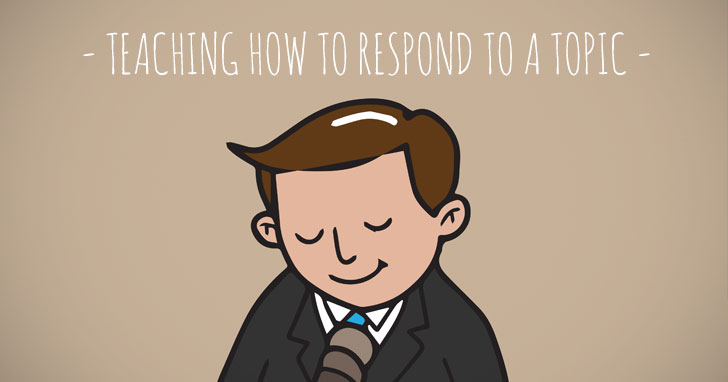What Do We Say About This? Teaching How to Respond to a Topic


And while they may chat away on a conversational topic such as their weekend plans and favorite music groups, they have more difficulty discussing an academic topic or contemporary issue such as right to bear arms or gun control. And finally, this is not because of the topic itself, necessarily. Indeed, the student may understand the topic well, hold an opinion on it and express her support or opposition to the issue and even respond to a peer’s position in a minimal way, the response is just that—a minimal response, and the lack of development in the response not related to the student dynamics or the task but rather that students don’t have the skills or language to engage in and extend academic dialogue. Given that truly engaging dialogue can be difficult for teachers, it’s not surprising it is for students. However, there are specific skills and language teachers can coach students in to help them really engage with a topic beyond the superficial.
Below are some strategies for extending an academic discussion that an instructor can teach and model for students.

Often the best way to start a discussion is simply to ask students thoughts on it. “So what did you think about the reading?” or “What are your thoughts on this topic?” Often the more gregarious students, after some hesitation, will volunteer a response; someone else will respond to the first student or volunteer or own response, and then the conversation takes off from there. If students have trouble getting started, some additional prompting from the instructor might be called for: “Shelby, what are your thoughts on the reading? Did you like or dislike it? Why?” or “Peter, what do you think about the author’s position on the topic? Do you agree or disagree?” Often just generally opening the topic is all that is needed for students to take over.
Another strategy an instructor might use is to give her own position on the topic. E.g., “The evidence shows that the United States has benefited more than it has lost from immigration. What do you think?” Students will then offer a response and a position, and if they don’t, the instructor can call on students to give their opinion on the topic and support for it.
The instructor can, as mentioned above, ask for a student’s opinion on a topic. Another option is to direct a student to ask other students their opinions. This will lead to students having to support their positions and in doing so extending the discussion.
Stating one’s position on a topic—e.g., health care should be supported by the government and offered to everyone as a matter of social justice—is a clear statement of a position with some rationale. It remains, however, limited in extending the discussion. Much stronger, with more opportunities to draw in other students, is giving a personal experience with healthcare or specific details on its costs, and this will lead to other students offering their own experiences. If students are not speaking up, the teacher can offer an experience of her own and ask students to draw the connection to the discussion and see the relevance. This will model what is meant by an “example” in this case, and students might then begin offering their own personal examples. This is also an opportunity to draw quieter students into the conversation that they might be hesitant to join on their own by asking them to contribute their own ideas.
Related to asking for examples is asking for clarification. Often discussions remain on levels of broad generalities, and this is a major reason they die out. Extending a discussion often requires pulling the discussion from this broad generality into the specific by asking for clarification: e.g., “You keep mentioning ‘justice.’ What does that mean to you, Jonathan, in this context?” As he explains it, then the discussion is extended.
Often, in discussion, students will bring up interesting ideas that are not quite to the point of immediate discussion, more “hold that thought” issues. These are points that should be returned to before the conversation is completely exhausted: “I remember Ashley brought up something interesting earlier, and I did want to return to that—” This not only leaves the individual student filling recognized but also extends the discussion.
Finally, students should learn the language of wrapping up a discussion while giving the opportunity for some last analysis: “We are running out of time; are there any further comments?” Often by then the conversation will be truly exhausted, but this does give the opportunity for those students to make a last point that they haven’t yet had a chance to express.
Extending discussion through responding to peers is not just for the sake of drawing out the discussion itself and filling class time. Rather, it is a matter of getting students to engage in critical analysis, think in specifics, use academic language, and practice the skills of academic discourse. Teaching students to engage with their peers and stick with an academic discussion requires patience. It is often the impulse, as students sits quietly, for the teacher to jump in and start talking or lecturing. However, with patient guidance, students will learn how to offer and support their own opinions, ask other students for their own elaborations and clarifications, and finally wrap up an excellent discussion.